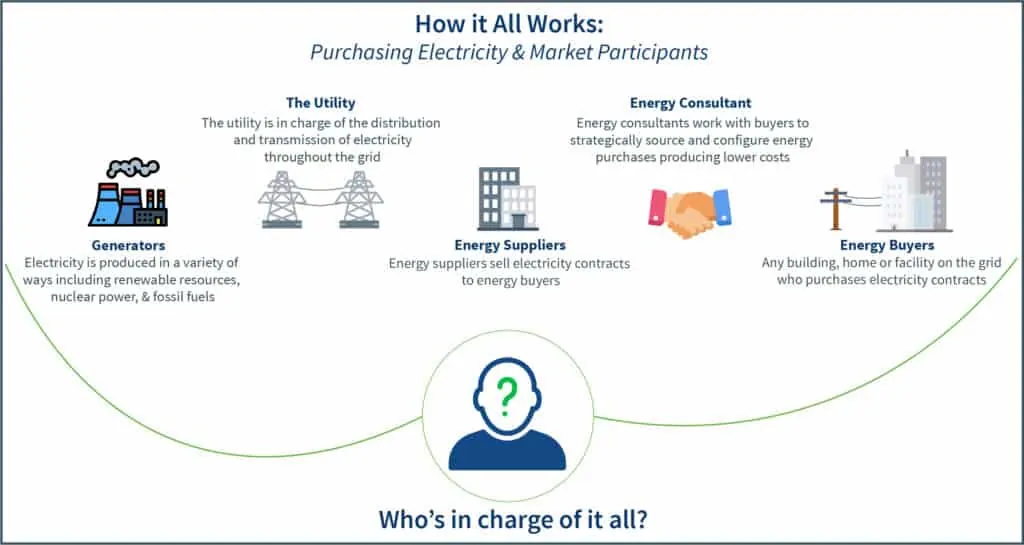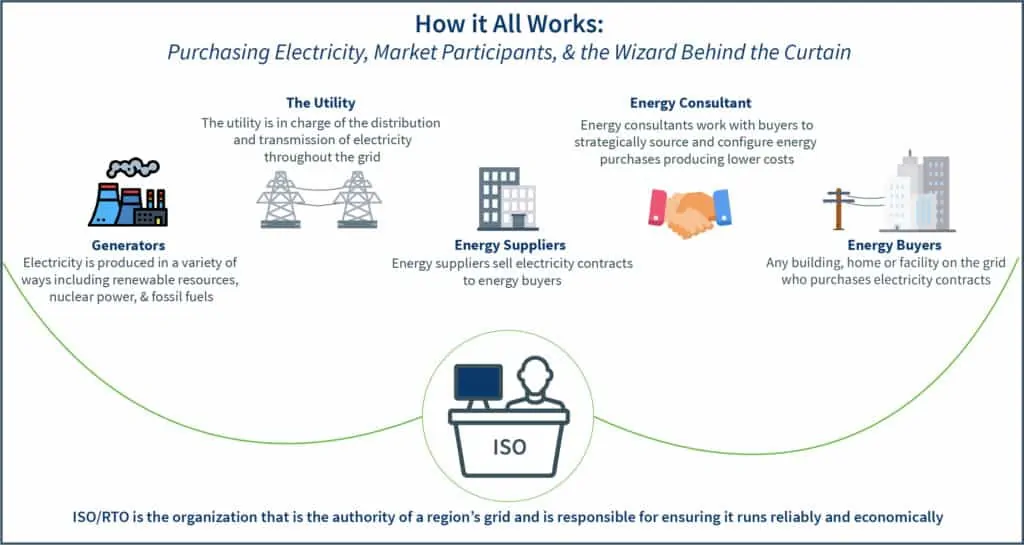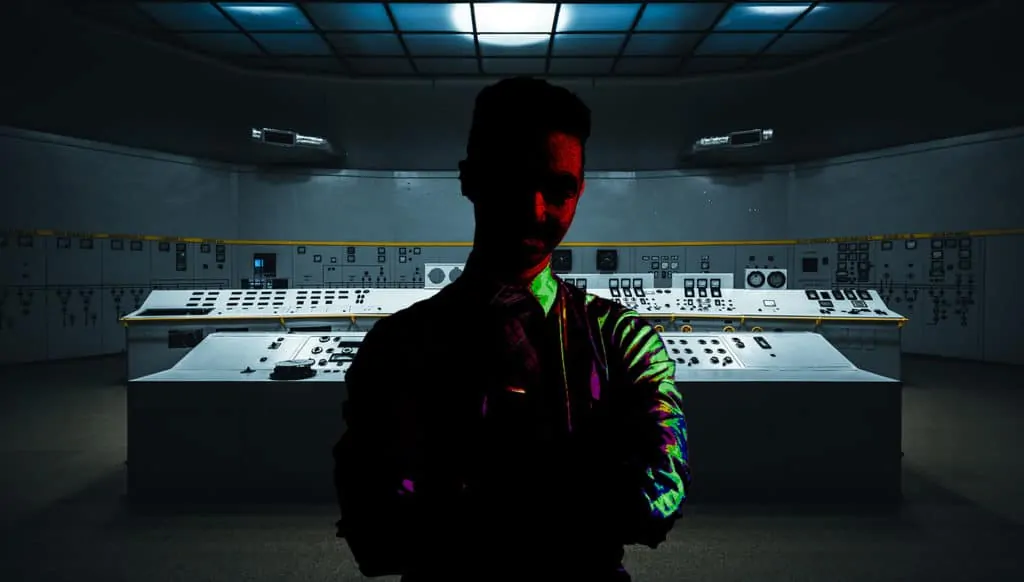What happens when you flip a light switch? A light bulb turns on! Electricity is pretty simple, right? Wrong!
Everyone knows that, at a bird’s-eye view, electricity flows from the point of generation, through the grid, and ends up at a building when something is turned on. We have confidence that flipping a light switch won’t immediately send a surge that burns a building to the ground so most don’t think much about it.
This assurance comes from our extremely complex and elaborate energy system that has been honed and smoothed over many years to ensure that electricity makes it way to the point of usage reliably and safely. While the system may have its own flaws, it is the lifeblood and backbone of our society.

Our modern energy system is made even more complicated when you throw in purchasing electricity, especially in deregulated markets! However, understanding where your electricity comes from is a vital step to mastering how to purchase it effectively and intelligently.
How Electricity Works – A General Overview
Our modern energy system is an astonishing mosaic of many cogs all working together to ensure everything operates as intended. Without each cog performing its function in the intended way, the whole system would collapse. This is one of the many ways black outs and brownouts occur.
At a high-level, the usage of electricity works like this: Various generators (nuclear power, wind turbines, coal, oil, natural gas, etc.) create the commodity which is distributed and transmitted by the utility from the point of creation through the grid and into buildings and homes as needed.
When purchasing electricity in deregulated states, it works like this: Suppliers purchase wholesale electricity market futures and sell them back to energy buyers in the form of retail contracts. Energy consultants facilitate this transaction and add value to the process by utilizing market insight & intelligence to drive market competition between suppliers, tailor purchasing strategies to businesses, and forming protective contracts, all of which results in overall lower costs for energy buyers.

In regulated states the journey electricity takes is the same, however, there are no 3rd party supplier option so energy buyers have to purchase their electricity contracts from the utility as they are the only provider available. With no competitive pricing in the market here, energy buyers are at the mercy of the rates set by the utility, which is called ‘default service’.
So, if electircity has this long journey to take and a million intricacies involved in the purchasing of it, who facilitates the market and is in charge to ensure the whole process goes off without a hitch? Well, that’s where our own electricity journey will start.
Meet the wizard behind the curtain: The ISO/RTO.
What are ISOs/RTOs?
We’re not kidding when we say the wizard behind the curtain. That’s because the ISO or independent system operator (sometimes called RTO or regional transmission organization) is an organization formed at the recommendation of Federal Energy Regulatory Commission (FERC) that coordinates, controls, and monitors the electric grid in a specific geographical, multi-state areas. They are the premier electricity authority in charge of both the entire electrical grid as well as the market process in a designated area. If the grid was OZ, the ISO/RTO would be The Wizard.
Contrary to popular belief, ISOs/RTOs are not a part of any government; they are organizations who operate, well, independently.
Life Before the ISO
Before the ISO, single entities owned the generation, transmission, and distribution of electricity on the grid. Energy buyers had little to no choice of who they could purchase energy from, which resulted in nefarious business practices, monopolies, and overall higher prices for customers. This system also made it very difficult for new providers who wanted to move into the space to generate, transmit, or provide electricity to buyers.
To fix this issue, the federal government passed a series of laws that outlined the concept of Independent System Operators and Regional Transmission Organizations with the intention that they would provide oversight and non-discriminatory access to transmission. These laws also led to separating the utility’s operations of generation, transmission, and distribution.
Eventually this all led to energy deregulation in states, albeit still with some federal, state, and local entities/commission oversight. Energy deregulation allows for competition in the marketplace and, thus, lower electricity prices for energy buyers. So you can thank the ISO for your ability to have unimpeded access to electricity as well as competitive prices for your contracts! To learn more about the history of energy deregulation, check out this post.

What exactly do ISOs and RTOs do?
ISOs/RTOs were formed to reduce government oversight, increase market competition, and to advocate for economic efficiency, grid reliability, and police all market participants to ensure their actions are unbiased and neutral.
Specifically, ISOs and RTOs are responsible for the following:
- Dispatching power plants and planning for expansion & new resources within its region
- The management and relief of congestion
- Controlling transmission facilities for voltage, monitoring, and switching in and out of service
- Keeping the power grid balanced between generation and load
- Forecasting and scheduling generation to ensure sufficient generation and backup power is in place to meet demand
- Providing the platform for the electricity market transactions and managing the process
As you can see ISOs/RTOs have a great deal of responsibility, and there is much more to it than that, but it can all be boiled down to this: they are the electricity authority in their controlled area in charge of running the power grid to ensure it is reliable, safe, and economical. Without the ISO/RTO, there would be nothing to oversee the entire grid, which would likely end in cataclysmic failure.
Our entire civilization requires electricity to keep it going so, if you view the entire electrical grid as a body, the electricity is the blood running through it and the ISO is the brain in charge of everything. Without the brain, the whole system does not work.
The ISOs and RTOs of the United States
ISOs and RTOs serve the same function, however, RTOs typically control a larger geographical area. There are currently 9 ISOs and RTOs in the United States. Best Practice Energy services the following ones:
- ISO-NE
- Rhode Island, Massachusetts, Connecticut, New Hampshire, and Maine
- NYISO
- New York City and the rest of the state
- PJM Interconnection
- Parts of DE, IL, IN, KY, MD, NJ, NC, OH, PA, TN, VA, WV, DC
- ERCOT
- Texas

Each ISO/RTO is, as the name implies, independent so, while the electricity supply they serve is generally the same, there are quite a few small variations that make big differences in the average energy buyers’ electricity costs. The two biggest variations are the components of an electricity supply price and how each determines capacity tags (rates).
For information on how each ISO and RTO prices capacity and how you can reduce those costs, check out these posts:
To find out about the intricacies and variations of the electricity supply prices from the ISO/RTO, take a look at these posts:
As we’ve stated over and over in this post, our energy system is extremely complicated. While the responsibilities of the ISO/RTO seem incomprehensible and unfathomable, there are so many other intricacies and other organizations working to keep everything going reliably ensuring that when you flip a light switch, your light turns on without issue. If one of these cogs were not operating properly, the entire system would malfunction.
The good news is understanding the ISO/RTO is the first and probably most perplexing piece of the electrical system! Each stop on our journey will give you a greater understanding of electricity and how the whole system works, which will help you discover how to fully take advantage of the system to reduce your own electricity costs.
The next stop on our electricity journey is to look at where the actual commodity comes from and how it is produced: Generation! This post will be coming soon so be sure to follow us on Facebook, Twitter, and LinkedIn for updates!
